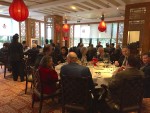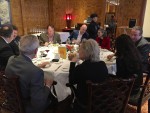During our Tuesday lunch at the Kempinski, we had as speaker Ms. Philippa Jones, Managing Director of China Policy. Topic: Feeding China: you have not seen anything yet!
See here an overview by our Club:
China’s agriculture may have reached an inflection point. Grain production is at all time highs, as are reserves. Agriculture, like industry is suffering from overcapacity. But costs have skyrocketed and land in many areas is exhausted and, in some others, polluted. For the last thirty years the government has been more or less happy to let the agriculture system continue, and since accession to the WTO in 2001, has gradually increased subsidies to support prices. This is now changing. Funds are being directed to the countryside and a massive legislative agenda is underpinning an aspirational desire for change on the part of the state.
Changing diets, as incomes grow, are also driving agricultural change. China own production of corn, mostly used for feeding pigs, and its imports of soybeans (60% used for animal fodder) have risen sharply.
The presentation illustrated changing production and imports of basic commodities, compared China’s production to the rest of the world, described the dilemma of price support amid rising costs, including storage of reserves and detailed the post-WTO accession rise of subsidies.
To counter the issues facing agriculture the administration has an aggressive agenda to upscale farms, increase mechanisation, make full use of big data, introduce e-commerce, consolidate markets and last but not least elevate peasants into professional farmers.
This new agenda is being implemented against many insuperable obstacles. Land reform is a central problem. Many in government and the Party cannot sanction the possibility of a landless class of peasants, should land become freely saleable. As young people settle in the cities, the countryside lack incentives to bring them back home. Xi Jinping himself has asked who will feed China? Constraints of exhausted land and lack of water will only exacerbate the situation.
Philippa expects a bumpy ride over the next few years as new models are tested ,and China attempts to integrate further into global agricultural markets.
(thanks to Celine for the pictures)
I also gave a short comment on my trip along the Yangtze River.





